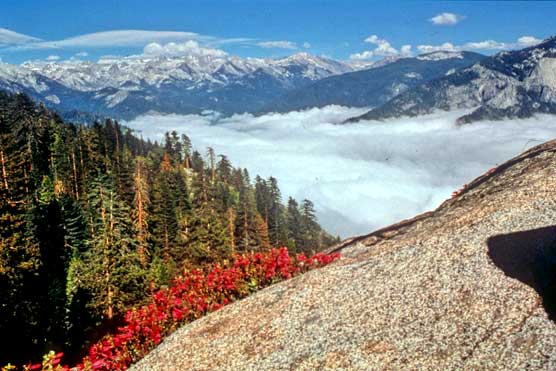Onward and forward.
It was a trip I made not too long after I settled in California’s San Joaquin Valley in 1977 to Sequoia and Kings Canyon national parks, which pretty much lie east of Fresno. By “not too long,” we’re talking within 10 years.
Sequoia and Kings Canyon for me were not exactly high on my list of either national parks or places to visit. In the same breath I can say that after visiting I’m glad I made the trip. The parks have their own attractions like Moro Rock, Crystal Cave, The General Sherman (not just a giant sequoia but the world’s tallest tree – period; clue: could this be how the park got its name?), Tharp’s Log (a “real” log cabin, as it is a hollowed-out tree) and other prominent features.
To put things in perspective, it is helpful to reference the Nov. 5, 2012 post: “Smog more than an eyesore – it’s a wake-up call,” my very first on the Air Quality Matters blog and the introductory passage in particular due to its poignancy, relevancy.
“On a visit to Sequoia National Park and to Moro Rock in particular once I overheard a man talking to whom I had assumed to be his young daughter, making reference to the blanket of smog off to the west covering the San Joaquin Valley floor. To the trained eye, unmistakable was the grayish-brown haze. However, to a juvenile whose feet were still very, very wet in terms of trying to discern just what the elder that she was standing beside had noticed, the child hadn’t a clue – something much akin to the both of them doing an about-face and then not being able to see the forest for the pine trees standing before them.”
Being in Sequoia National Park and looking out over the Valley floor and seeing a muck so thick and ugly, that it blocked, from the eye, all that sat below it, is sad, sad commentary indeed. And, it isn’t like this was a one-time event; sadly, it’s a regular warm-weather-related occurrence. And, it’s not just this: smog from the Valley floor regularly makes it into both of the national parks.
And, one more thing: about that post title: “Smog more than an eyesore – it’s a wake-up call,” is it a wake-up call, really? All right: I apologize for getting off topic.
In getting back with the program, the “program” of clean and not dirty air, and the reason I created this series, my visits to Kings Canyon and Sequoia national parks were enlightening, educational. Not only did I take a walk out on the Sequoia National Park-based granite outcropping otherwise known as Moro Rock but in addition, I also ventured deep inside the Crystal Cave cavern. What I vividly remember is, in one accessing Moro Rock, it required an uphill walk while in reaching the cave it necessitated doing just the opposite. An interesting juxtaposition to be sure!
I earlier mentioned sad commentary. Indeed the converse regarding the awe-inspiring content of the accompanying photo below.
Whereas on my Sequoia visit, I witnessed an enveloping scourge – smog – covering the San Joaquin Valley floor, nothing could be farther from that as exemplified by the clouds in this depiction. If a picture is worth a thousand words this one says it all. And that’s putting it mildly!

Image above: National Park Service
– Alan Kandel
This post was last revised on Dec. 8, 2019 @ 7:27 a.m. Pacific Standard Time.
Most visitors expect clean air and clear views in parks. Sequoia Kings Canyon National Parks (NPs), in California, are home to huge mountains, rugged foothills, deep canyons, vast caverns, and the world’s largest trees. The parks also experience some of the worst air pollution of any national parks in the U.S. The parks are downwind of many air pollution sources, including agriculture, industry, major highways, and urban pollutants from as far away as the San Francisco Bay Area. Air pollutants blown into the park can harm natural and scenic resources such as soils, surface waters, plants, wildlife, and visibility. The National Park Service works to address air pollution effects at Sequoia Kings Canyon NPs, and in parks across the U.S., through science, policy and planning, and by doing our part.